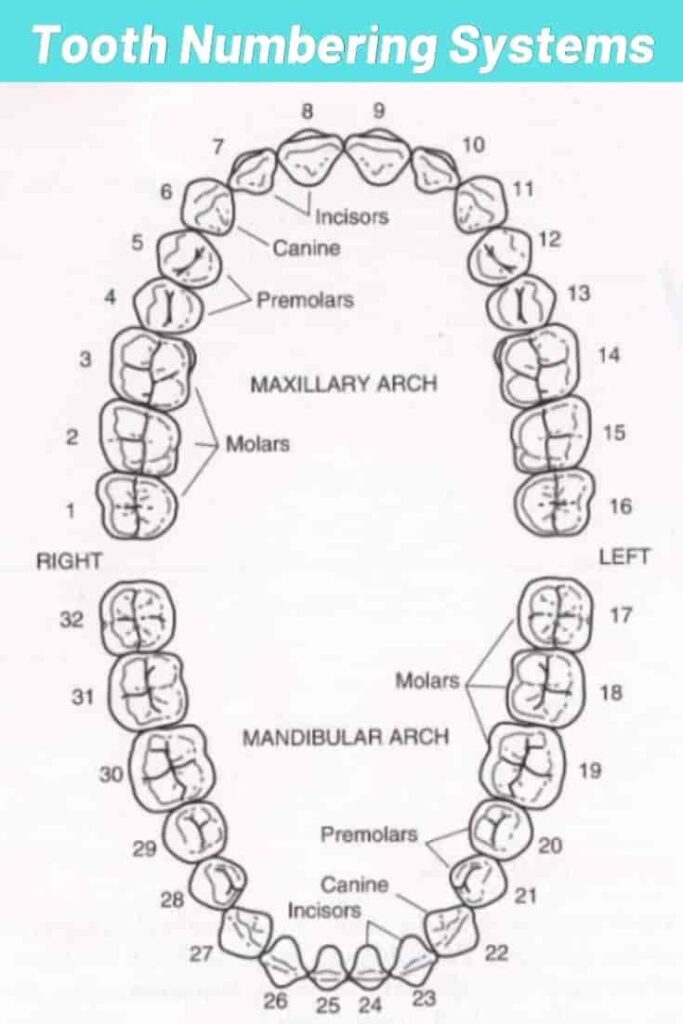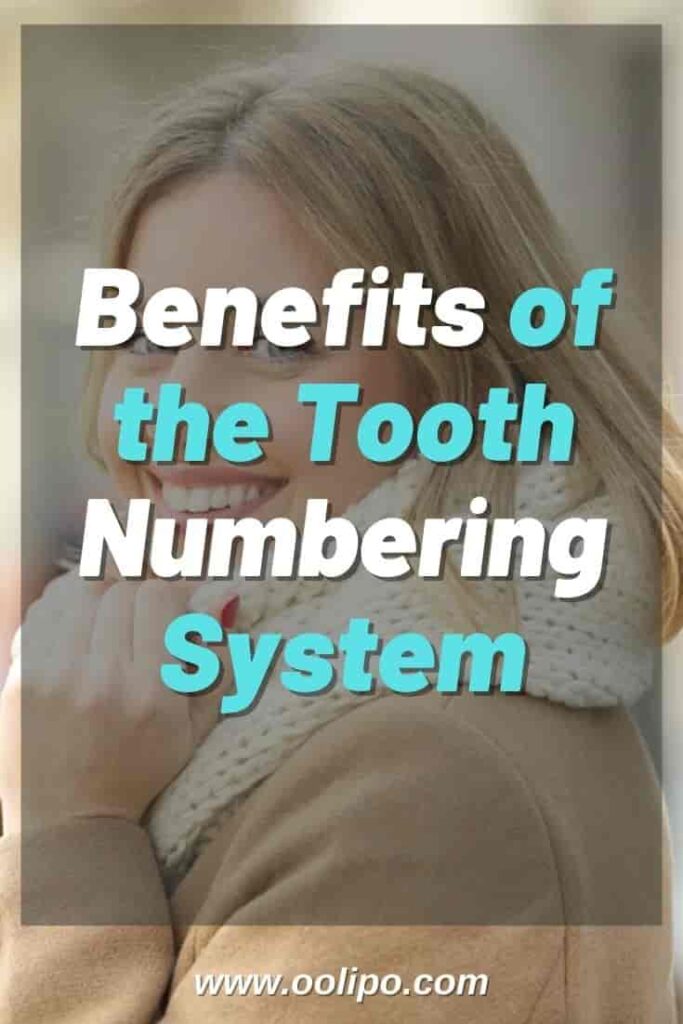An adult human has 32 teeth in his mouth and these teeth are grouped as wisdom, morals, premolars, incisors, and canines. What are these wisdom teeth numbers? How to find yours in the dental tooth system?
Teeth are given numbers from 1 to 32, there are several different tooth numbering systems and these numbers make the work of dentists easier.
Benefits of the Tooth Numbering System
Here are some of the most common benefits:
- Specify linked threads
- Communication and dental record maintenance
- Easy identification of teeth
- Clinical identification
- Radiographic identification
- Assessing dental diseases
Wisdom Teeth Numbers in Tooth Numbering Systems
The most popular numbering systems:
- Universal Numbering System
- Zsigmondy-Palmer System (1861 – Palmer’s Notation)
- FDI System Numbering System
- Victor Haderup System
- MICAP System
- Woelfel System
Tooth numbering systems numbered the 32 teeth we have in adulthood, but each system has notes for milk teeth to understand primary teeth correctly.
Wisdom Teeth Numbers: 1, 16, 17, 32
Molars Teeth Numbers: 1, 2, 3, 14, 15, 16,17, 18, 19, 30, 31 and 32
Premolars Teeth Numbers: 4, 5, 12, 13, 20, 21, 28 and 29
Incisors Teeth Numbers: 7, 8, 9, 10, 23, 24, 25 and 26
Canines Teeth Numbers: 6, 11, 22 and 27

The following model is the sequential naming pattern of the Universal Numbering System as designated by American Dental Association:
Teeth Number 1: 3rd Molar commonly known as wisdom tooth (first number)
Teeth Number 2: 2nd Molar
Teeth Number 3: 1st Molar
Teeth Number 4: 2nd Bicuspid also known as 2nd premolar
Teeth Number 5: 1st Bicuspid or 1st premolar
Teeth Number 6: Cuspid or canine
Teeth Number 7: Lateral incisor (upper right)
Teeth Number 8: Central incisor (upper right)
Teeth Number 9: Central incisor (upper left)
Teeth Number 10: Lateral incisor (upper left)
Teeth Number 11: Cuspid (canine/eyetooth)
Teeth Number 12: 1st Bicuspid or 1st premolar
Teeth Number 13: 2nd Bicuspid or 2nd premolar
Teeth Number 14: 1st Molar
Teeth Number 15: 2nd Molar
Teeth Number 16: 3rd Molar or wisdom tooth
Teeth Number 17: 3rd Molar or wisdom tooth (lower left)
Teeth Number 18: 2nd Molar
Teeth Number 19: 1st Molar
Teeth Number 20: 2nd Bicuspid or 2nd premolar
Teeth Number 21: 1st Bicuspid or 1st premolar
Teeth Number 22: Cuspid or canine
Teeth Number 23: Lateral incisor
Teeth Number 24: Central incisor
Teeth Number 25: Central incisor
Teeth Number 26: Lateral incisor
Teeth Number 27: Cuspid or canine
Teeth Number 28: 1st Bicuspid or 1st premolar
Teeth Number 29: 2nd Bicuspid or 2nd premolar
Teeth Number 30: 1st Molar
Teeth Number 31: 2nd Molar
Teeth Number 32: 3rd Molar (lower right wisdom tooth)
Dental Dials
To understand the tooth numbering system, it is first necessary to understand the tooth dials. The teeth are divided into four quadrants, The upper arch has two sections, the upper right and left upper sections, called the first and second quadrants, the third and fourth quadrants belong to the lower jaw.
Dental charts are prepared from the point of view of dentists, making their work easier. Right-hand teeth are shown on the left side of the chart and left-hand teeth are shown on the right of the chart.
If you can understand the dials, you can quickly and easily find a tooth specified in their naming system.
Universal Numbering System
In 1882, German dentist Julius Parreidt proposed the Universal Tooth Numbering System. This system, in which permanent and eruptive teeth are named differently, has been accepted and approved by the American Dental Association (ADA).

This proposed numbering system was found to be successful and became the most used numbering system by dentists in America. However, this system had its drawbacks, it was not sufficient to classify teeth. This numbering system continued to be used for many years as it facilitates the finding of the relevant tooth and is easy to understand.
Notes and Other Information About Teeth
We lose our baby teeth by the age of 13 and we have permanent teeth. By the age of 25, we have 4 extra teeth, called wisdom teeth, which grow in the back of our mouth.
The canine teeth are #6 and #11 on the upper jaw and #22 and #27 on the lower jaw. The reason why canine teeth are called “eye teeth” is that the long root extends almost to the eye socket. They are the first teeth to be eroded, as they are used for biting.
Your third molars come out between the ages of 17 and 21, and if your wisdom teeth need to be extracted, you should not leave them until later ages. The right second molar is called A, the left second molar is given the letter J, and the deciduous teeth are started to be named.
The two upper middle front teeth are #8 and #9 and are defined as the right upper central incisor and the left upper central incisor.
If the dental chart is not prepared from the perspective of the dentist, it can be difficult to use and learn. The universal numbering system is used as a reference as if you have all the teeth in your mouth, even if you have wisdom teeth removed, your upper right wisdom tooth is considered number 1.
The numbering of teeth continues along with your upper teeth until your farthest tooth, number 16. If you count clockwise starting from #17, which is the lower-left wisdom tooth, you will have #32 your lower right wisdom tooth.
Children’s Teeth
Children’s teeth in the upper right are called the first tooth, and the teeth in the lower right are called the last tooth.
The first row of primary teeth is the posterior part of the upper right quadrant, where the right second molar, called A, is on the left posterior aspect of the left second molar dental arch and continues up to the letter J.
For dental professionals working in dental clinics, the dental chart provides an advantage for trainees to teach the job.
More than 32 different systems have been created for the identification of human teeth, and it has become easier to refer to particular teeth.
Supernumerary teeth do not have a specific location, can occur anywhere in the mouth, and are defined in addition to the series of permanent teeth.
The characteristic of malocclusion is due to overlapping or crooked lower teeth, and if left untreated, it will adversely affect other teeth, insurance companies cover these treatments.
Palmer Notation Method
There was the palmer notation method (palmer notation system) in the appendix and it was difficult to use the symbols of this method on keyboards. That’s why in 1968 the association officially announced its support for the Universal System, and later the World Health Organization and the Federation Dentaire Internationale officially started using the two-digit numbering system.
When you have missing teeth, the dual system is important because it needs to be located and proper communication between dentists is established.
Molars
Molars are large 4-pointed teeth located at the back of the mouth behind premolars, adults have 12 molars, 4 of which are wisdom teeth.
If your front tooth is missing, your dentist will apply a procedure called bonding, which uses composite resin to make your tooth look natural, so you can smile comfortably. New techniques are developed for an oral surgeon and patients’ comfort is increased.
The first premolar has sharper, more prominent spikes than the second premolar, and the buccal apex is larger than the palatal apex.
Universal Numbering System
Although the classical tooth numbering system is used in adults for wisdom teeth numbers, the modified version of the Universal Numbering System is used in children.
We start to lose our baby teeth at the age of 5 and this continues until the age of 13 when we become adults we have 32 teeth in our mouth and we have the full set of adult teeth in our late teens.

If the upper left wisdom tooth is difficult to come out, the gums and surrounding area may become infected and swollen. In such a case, you should go to a Maxillofacial surgeon.
The services your dentist offers, how much insurance you will benefit from and the total fees you have to pay will affect your dental treatment plan.
The rearmost tooth on the right side of your mouth in the upper jaw is called the #1 tooth. The number 1 flat, front job is in the upper right section of the mouth and is an incisor.
When you go to the dentist, you will hear some tooth numbers say, when you hear the numbers of your teeth, you can understand which tooth is mentioned by looking at the dental chart.
Tooth Decay
Tooth decay is one of the potential problems that may occur in your teeth, it can pose a greater risk in specific teeth and damage soft tissue.
You will need a handy guide for dental care, in cases such as gum disease, you may have a missing tooth problem and your specific tooth may need treatment.
If your tooth has started to break, it may be an impacted tooth, you should have that tooth treated before you encounter a bigger problem.
The numbers given to your teeth continue down to the lower jaw, and #17 is the rearmost tooth on the left side of your mouth.
Teeth Hygiene
You should brush your teeth for 2 minutes, which means you should brush for 30 seconds of a quadrant of your mouth, also don’t forget to brush your tongue.
In some types of treatment, surgical removal of the upper right canine and enlargement of the area may be required, particulate graft material is used for augmentation.
There are 4 canines, these teeth are located on each side of the upper and lower incisors, these teeth are called cuspids.
The last set of teeth to erupt are the molars and contain 4 wisdom teeth, they emerge between the ages of 17 and 25.
Your top and bottom teeth are usually not touched, but if you have a lower toothache, the first thing you should do is visit your dentist, you can prevent tooth loss with early intervention.
Protecting Your Teeth
Protecting your teeth is not the only reason you care about your oral hygiene, oral hygiene is related to the intestines and allows you to prevent many other health problems.
Apart from the visible part of your tooth, there is also a root, and the root of the tooth extends to the jawbone. These tooth roots have blood vessels, in this area called the pulp, blood vessels supply blood and sensation to the tooth.
Your age, diet, and genetics determine the number of teeth you will have.

Even if you do not have a problem with your teeth right now, choose general dentists today, because you will definitely need them in the future.
You can find many successful dentists in the United States of America, maybe a little pricey but well worth it for your health.
Summary of Wisdom Teeth Numbers
When people are 6 months of age, their baby teeth start to come in and they usually have 20 teeth.
In the center of your teeth are nerves, this space, which also contains connective tissue and blood vessels, is called the pulp chamber.
Visiting the dentist can be stressful and boring, but the weirdest thing is all the numbers dentists and assistants tell each other.
The wisdom teeth numbers start from 1 to 32, your upper left wisdom tooth is number 16 and your lower left wisdom tooth is number 17.
If the original system is used in dental treatment, you can understand which tooth has a problem from your tooth number.
According to the biting surface, an abrasion or fracture in your teeth can be understood and treated.
To identify your teeth, each of your teeth must be identified with an individual number according to the universal numbering system.